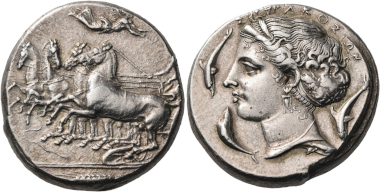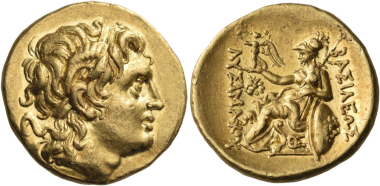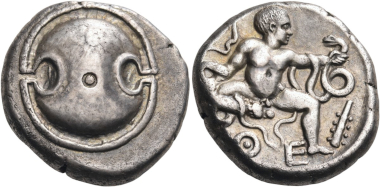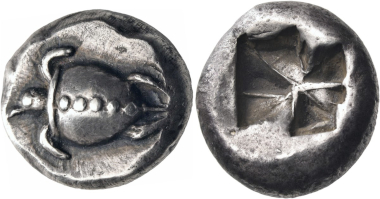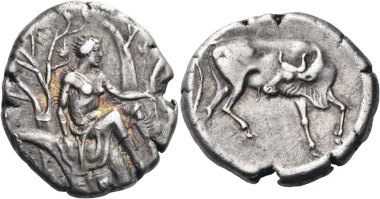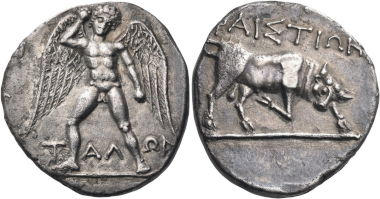25-10-2018 – 01-01-1970
Nomos 17
Marvellous Greek Coins at Nomos Auction 17
Nomos Auction 17 will take place in Zurich on 26 October 2018. Nomos will begin selling the Vineyard Collection, a specialized group put together by a collector who is passionate about wine: all his coins are wine-related in some way. Very considerable numbers of coins from the Vineyard Collection will also appear in forthcoming Obolos sales. A highlight of the Roman section is the DeBakey Collection of aurei, which includes coins with good portraits and interesting reverses. Otherwise, there are coins from a variety of owners, in a variety of price ranges. Here Alan S. Walker presents some of the highlights from the Greek section:
Last time I wrote about a miscellaneous group of coins from Nomos 17 – this time I am going to try and just present some major highlights. Yes, the word “highlights” tends to be used for coins that are rare, impressive and expensive: so, make yourself a gin and tonic, or get out your usual bottle of Chateau Lafite Rothschild, sit back and enjoy…
The Sicilian aristocracy of the late 6th and 5th centuries BC were famous for their wealth; one way of emphasizing that was through their support of chariot racing – since participating required large amounts of money to pay for the horses and the equipment. As we know, the winner’s crown went to the owner, not the driver – being a driver was very dangerous and really high status people did not want to take the risk –, nevertheless, scenes of victories at the races were a common type on the coins of the Sicilian states.
Lot 53: Sicily. Syracuse. Dionysios I, 405-367 BC. Tetradrachm, unsigned but by Parmenides, c. 395. Very rare. Extremely fine. Estimated: 37,500 CHF.
Here we see, on the obverse of a tetradrachm of c. 395 BC (lot 53, est. 37,500), which is from dies cut by the engraver Parmenides (though unsigned), showing the winning quadriga at the races. Nike is flying to crown the driver, unfortunately not on the flan, but we have an excellent view of the team of horses, about to round the turn into the final stretch of the race. It has been hectic: one of the horse’s reins has fallen loose and another chariot went out of the race due to a major accident, in which the wheel fell off (seen below our horses’ hooves. On the reverse of this coin we have a beautifully made head of Arethusa, her hair bound in a decorated scarf-like net. This is actually the finest known specimen of this type.
Lot 82: Kings of Thrace. Ptolemy Keraunos, 281-279 BC. Stater in the name and with the types of Lysimachos, Lysimacheia, 281-280. Of the greatest rarity, the second known example. Some very minor marks on the reverse, perhaps at the time of minting, otherwise, virtually as struck. Estimated: 32,500 CHF.
Our next piece is a very special gold stater. It is in the name and of the types of Lysimachos, but the most recent research makes it clear that this coin was actually issued for the rather swashbuckling and disreputable son of Ptolemy I, Ptolemy Keraunos (the Thunderbolt), born c. 321 and died in 279 (lot 82, est. 32,500).
After he was forced to flee Egypt he ended up as a refugee with Lysimachos, who was married to his half-sister Arsinoe. Not receiving the respect he thought was his due, he then fled to Seleukos whom he convinced to attack and destroy Lysimachos – he then assassinated Seleukos (!) and was king of Macedon from 281 until 279 when he was killed by the Gauls. This piece is the second and best known example of the type.
Lot 124: Boeotia. Thebes. Stater, circa 425-395 BC. Nearly extremely fine. Estimated: 15,000 CHF.
Here we have an infant, albeit very muscular, Herakles strangling a pair of snakes that had sought to bite him in his crib. These snakes were sent by Hera who was most annoyed by the existence of the young chap since he was the result of her husband Zeus having a short “flirt” with Alcmene (who was apparently his own great-granddaughter). In any event Herakles, who seems to have just finished a snack of spinach, made short work of the serpents, as shown on the reverse of this Theban stater, one of the finest of the type known (lot 124, est. 15,000).
Lot 135: Islands off Attica, Aegina. Stater, circa 550-530/25 BC. Very rare. A remarkably elegant, toned coin, very well-struck and well-centered, of outstanding quality. Estimated: 55,000 CHF.
Among the best known of all the Greek silver coins of the 6th and 5th centuries BC are the Turtles of Aegina, silver staters that were probably the first coins struck in Greece. Alas, not only are they among the best known, they are also among the most common of all the coins of that period, and also among those most commonly found in poor condition. Some of the coins struck in the 520s circulated down into the time of Alexander, and even later; their popularity is shown by the enormous number of countermarks that appear on them, validating their quality after the island temporarily lost her independence in the 5th century BC. Struck in vast numbers, many were misstruck in haste or produced from worn dies: really fine pieces, especially from the earliest issues, are very uncommon, indeed. This piece, lot 135, estimated at 55,000, is not only one of the earliest of the coins of Aegina, it is in spectacularly fine condition, beautifully toned and of excellent metal. It is from the collection of the Belgian physician, entomologist and numismatist, J. Desneux (1885-1962); while known to us for his study on the coinage of Akanthos, to many others he is famous for his work on Isoptera – termites!
Keen-eyed readers will not that in the Nomos 17 catalogue this turtle faces left – that is because I think it looks correct that way; however, the Hellenic school (D. Gerothanasis, prop.) thinks otherwise and, so, it is shown vertically here. Either way, this must be the finest example available.
Lot 145: Crete. Gortyna. Stater, circa 330-270 BC. Minor scuff on the obverse, otherwise, good very fine. Estimated: 55,000 CHF.
One of the big problems with the coinage of Crete is that much of the bullion used to make it came in the form of coins that had been used to pay Cretan mercenaries who served with the armies of numerous Greek states and rulers during the 5th, 4th and 3rd centuries BC. Obviously, since Crete produced coins on the Aeginetic standard, Attic weight coins (Athenian or Alexander tetradrachms, for example) would have to be melted down in order to be made into Cretan issues; however, a vast amount of Aeginetic weight coins were used to pay Cretans working for most of the states of the Greek mainland, and those coins could simply be overstruck to make new coins. In fact, while only one example of an Achaean League stater is known (in London, Kraay / Hirmer 516), others have been identified as the undertypes of various Cretan staters. But the present piece, a stater from Gortyna (lot 145, est. 55,000), is not only beautifully struck, it is apparently struck on a fresh flan. The obverse, with Europa sitting in a plane tree, almost certainly must have been copied from a contemporary painting rather than a sculpture. The quality of this coin is outstanding.
Lot 147: Crete. Phaistos. Stater, circa 320-300 BC. Extremely fine. Estimated: 60,000 CHF.
Finally, here is another Cretan coin of exceptionally fine quality. This is a stater from Phaistos (lot 147, est. 60,000), which is both very rare and very well struck – on a fresh flan. The obverse shows the famous bronze giant, Talos, the guardian of Crete, throwing a boulder to ward off an enemy. As the story goes, Talos had molten metal as blood in a single vein, closed by a nail in his heel; in order to vanquish him, Medea managed to dislodge the nail and all his blood ran out, destroying him. An interesting idea of the great classical scholar A.B. Cook was that the tale of Talos was a reference to lost wax process used in making bronze sculpture.
For the complete auction catalogue you can check Nomos Auction 17 on the Nomos website, on Sixbid, biddr, and NumisBids.



